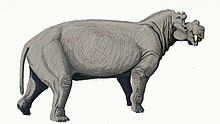Dinocerata
This article may need to be rewritten to comply with Wikipedia's quality standards. (March 2021) |
| Dinocerata | |
|---|---|

| |
| Uintatherium. | |
| Scientific classification | |
| Kingdom: | Animalia |
| Phylum: | Chordata |
| Class: | Mammalia |
| Clade: | Mesaxonia |
| Order: | †Dinocerata Marsh, 1872 |
| Families & genera | |
|
See text | |

Dinocerata (from the Greek δεινός (deinós), "terrible", and κέρας (kéras), "horn") is an extinct order of plant-eating hoofed mammals with horns and protuberant canine teeth.
Classification[]
A 2015 phylogenetic study recovered Dinocerata as closely related to Carodnia, making them part of the Euungulata assemblage.[1]
Taxonomy and phylogeny[]
Most experts[who?] place the known genera of Dinocerata within one family, Uintatheriidae, and split it into two subfamilies, Uintatheriinae and Gobiatheriinae. Some experts prefer to split Uintatheriidae into three families, with Gobiatherium placed in the monogeneric family Gobiatheriidae, the other Eocene genera in Uintatheriidae proper, and the Paleocene genera Prodinoceras and Probathyopsis placed in the family "Prodinoceratidae".
- Laurasiatheria
- Ungulatomorpha?
- Order Dinocerata
- Family Uintatheriidae
- Subfamily Gobiatheriinae
- Subfamily Uintatheriinae
- Family Uintatheriidae
References[]
- ^ Burger, Benjamin J. (2015). "The systematic position of the saber-toothed and horned giants of the Eocene: the Uintatheres (Order Dinocerata)" (PDF). Utah State University Uintah Basin Campus, Vernal, UT, 84078, United States Of America.CS1 maint: location (link)
- Dinoceratans
- Eocene extinctions
- Paleocene first appearances
- Fossil taxa described in 1872
- Mammal orders